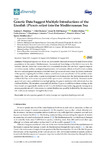Genetic Data Suggest Multiple Introductions of the Lionfish (Pterois miles) into the Mediterranean Sea
| dc.contributor.author | Dimitriou, AC | |
| dc.contributor.author | Chartosia, N | |
| dc.contributor.author | Hall-Spencer, Jason | |
| dc.contributor.author | Kleitou, Periklis | |
| dc.contributor.author | Jimenez, C | |
| dc.contributor.author | Antoniou, C | |
| dc.contributor.author | Hadjioannou, L | |
| dc.contributor.author | Kletou, D | |
| dc.contributor.author | Sfenthourakis, S | |
| dc.date.accessioned | 2019-08-30T21:04:06Z | |
| dc.date.available | 2019-08-30T21:04:06Z | |
| dc.date.issued | 2019-08-27 | |
| dc.identifier.issn | 1424-8220 | |
| dc.identifier.issn | 1424-2818 | |
| dc.identifier.other | ARTN 149 | |
| dc.identifier.uri | http://hdl.handle.net/10026.1/14835 | |
| dc.description.abstract |
<jats:p>Widespread reports over the last six years confirm the establishment of lionfish (Pterois miles) populations in the eastern Mediterranean. Accumulated knowledge on lionfish invasions in the western Atlantic Ocean has shown that it is a successful invader and can have negative impacts on native species, indirect ecological repercussions and economic effects on local human societies. Here we analysed genetic sequences of lionfish from Cyprus as well as data from the whole distribution of the species, targeting the mtDNA markers cytochrome c oxidase subunit 1 (COI) and the control region (CR). Our results reflect a pattern of repeated introductions into the Mediterranean from the northern Red Sea and a secondary spread of this species west to Rhodes and Sicily. Presented results agree with previously published studies highlighting the genetic similarity with individuals from the northern Red Sea. Nevertheless, some individuals from Cyprus, in addition to those coming via the Suez Canal, were genetically similar to fish from the Indian Ocean, indicating genetic homogeneity among populations of P. miles across its current distribution, possibly facilitated by the ornamental fish trade and/or transport through ballast water.</jats:p> | |
| dc.format.extent | 149-149 | |
| dc.language | en | |
| dc.language.iso | en | |
| dc.publisher | MDPI | |
| dc.subject | invasive species | |
| dc.subject | genetic diversity | |
| dc.subject | Lessepsian migration | |
| dc.subject | haplotype network | |
| dc.title | Genetic Data Suggest Multiple Introductions of the Lionfish (Pterois miles) into the Mediterranean Sea | |
| dc.type | journal-article | |
| dc.type | Journal Article | |
| plymouth.author-url | https://www.webofscience.com/api/gateway?GWVersion=2&SrcApp=PARTNER_APP&SrcAuth=LinksAMR&KeyUT=WOS:000487944500005&DestLinkType=FullRecord&DestApp=ALL_WOS&UsrCustomerID=11bb513d99f797142bcfeffcc58ea008 | |
| plymouth.issue | 9 | |
| plymouth.volume | 11 | |
| plymouth.publication-status | Published online | |
| plymouth.journal | Diversity | |
| dc.identifier.doi | 10.3390/d11090149 | |
| plymouth.organisational-group | /Plymouth | |
| plymouth.organisational-group | /Plymouth/Faculty of Science and Engineering | |
| plymouth.organisational-group | /Plymouth/Faculty of Science and Engineering/School of Biological and Marine Sciences | |
| plymouth.organisational-group | /Plymouth/PRIMaRE Publications | |
| plymouth.organisational-group | /Plymouth/REF 2021 Researchers by UoA | |
| plymouth.organisational-group | /Plymouth/REF 2021 Researchers by UoA/UoA07 Earth Systems and Environmental Sciences | |
| plymouth.organisational-group | /Plymouth/Research Groups | |
| plymouth.organisational-group | /Plymouth/Research Groups/Marine Institute | |
| plymouth.organisational-group | /Plymouth/Users by role | |
| plymouth.organisational-group | /Plymouth/Users by role/Academics | |
| dcterms.dateAccepted | 2019-08-23 | |
| dc.rights.embargodate | 2019-12-18 | |
| dc.identifier.eissn | 1424-2818 | |
| dc.rights.embargoperiod | Not known | |
| rioxxterms.version | Version of Record | |
| rioxxterms.versionofrecord | 10.3390/d11090149 | |
| rioxxterms.licenseref.uri | http://www.rioxx.net/licenses/all-rights-reserved | |
| rioxxterms.licenseref.startdate | 2019-08-27 | |
| rioxxterms.type | Journal Article/Review |


